Is it a Robe? Is it a Jacket? It’s a Kimono!
What is a kimono
Kimono: (Japanese: ki : wearing, mono: thing, Singular: Kimono) A traditional Japanese long loose robe with wide sleeves tied with a sash around the waist. Presently it is the national dress of Japan. ? The answer to that would generally be ‘the complex-looking traditional garments, worn by Japanese women, that are more often than not accompanied by even more complex-looking, larger-than-life bows.’ 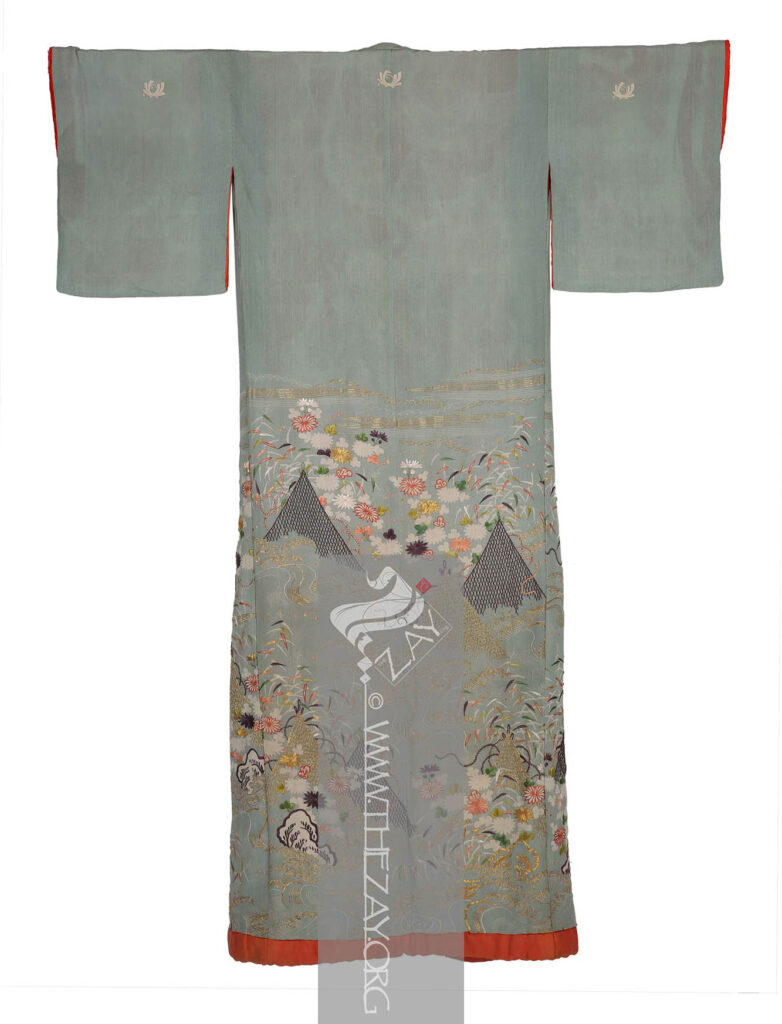 A later Japanese kosode
Kosode: (Japanese: small sleeve or opening), a traditional Japanese inner robe for both genders. Similar to a kimono but with a wider body, longer collars, and narrower and rounded sleeves, often stitched to the body, these under robes were lavishly decorated and were worn on top from late 16th century. style kimono
Kimono: (Japanese: ki : wearing, mono: thing, Singular: Kimono) A traditional Japanese long loose robe with wide sleeves tied with a sash around the waist. Presently it is the national dress of Japan. ; “Jade green silk women’s robe”, Japan c. 1915; Acc No: ZI2017.500768 ASIA; Source: The Zay
Zay: (Arabic: costume, Pl. azyaā’), a set of clothes in a style typical of a particular country or historical period. Initiative, LINKWhile that explanation would not be absolutely wrong, it would certainly be incomplete. While to the outside world, who by and large are used to wearing a bodice
Bodice: (English: body), or bodices the plural form of body, it is the close-fitting garment meant to cover the body above the waist or the torso. However, it was not until the 17th century that the term became synonymous to women’s undergarment. and a pair of trousers in some form or another, or a tunic of some kind, a kimono
Kimono: (Japanese: ki : wearing, mono: thing, Singular: Kimono) A traditional Japanese long loose robe with wide sleeves tied with a sash around the waist. Presently it is the national dress of Japan. may look daunting yet undoubtedly beautiful at the same time. However, the complexity of a kimono
Kimono: (Japanese: ki : wearing, mono: thing, Singular: Kimono) A traditional Japanese long loose robe with wide sleeves tied with a sash around the waist. Presently it is the national dress of Japan. is not in its complicated bow or its drapes, it is in the etiquette. A kimono
Kimono: (Japanese: ki : wearing, mono: thing, Singular: Kimono) A traditional Japanese long loose robe with wide sleeves tied with a sash around the waist. Presently it is the national dress of Japan. is not just a mere garment to be worn when attending parties or going out, it is a symbol that defines the essence of the moment. From “Kon'nichiwa” to “Sayōnara” there is a kimono
Kimono: (Japanese: ki : wearing, mono: thing, Singular: Kimono) A traditional Japanese long loose robe with wide sleeves tied with a sash around the waist. Presently it is the national dress of Japan. for every occasion, and each one of them is bound to be a work of art and love, dedication and perfection. Japanese kimonos have captured the essence of Japanese culture and tradition for centuries. Steeped in socio-political history involving trade and cultural exchanges between nations, the history and evolution of the kimono
Kimono: (Japanese: ki : wearing, mono: thing, Singular: Kimono) A traditional Japanese long loose robe with wide sleeves tied with a sash around the waist. Presently it is the national dress of Japan. is indeed fascinating – a thorough exploration of which shall be shelved for the time being, as it could only be possible in a space dedicated to it. However, we do require a basic knowledge of Japanese history starting from around the 8th century CE. The ancient and medieval period witnessed a great deal of Sino-Japanese cultural exchanges. There has always been a solid socio-cultural bonding between the two nations through trade and politics, especially during the Tang Period (c. 618-907 CE) in China. Japan had been involved in 19 cultural and trade expeditions to China between c. 607-838 CE. Things were going great until multiple shipwrecks, vessel damages, and unfavourable wind conditions prevented further exchanges. Up until the early Heian Period (c. 794-1600 CE), Japanese court fashion was almost always heavily influenced by Chinese products, especially textiles. However, with the failed expeditions, Chinese imported goods did not even make it to the Japanese ports, which essentially meant that even the upper class, the so-called bastions and creators (arguably) of culture, who otherwise could both afford and were allowed to wear imported clothes, were prevented from it. Thus, impeding them from establishing a tradition, and disseminating it within the existing Japanese society and creating space and opportunity for the development and evolution of indigenous Japanese culture and traditions independent of Chinese influences. Of course, there were remnants of existing Chinese influences that cannot be completely ignored, but by and large, an independent cultural identity was formed that evolved over time to reflect Japanese aesthetics and values.
A later Japanese kosode
Kosode: (Japanese: small sleeve or opening), a traditional Japanese inner robe for both genders. Similar to a kimono but with a wider body, longer collars, and narrower and rounded sleeves, often stitched to the body, these under robes were lavishly decorated and were worn on top from late 16th century. style kimono
Kimono: (Japanese: ki : wearing, mono: thing, Singular: Kimono) A traditional Japanese long loose robe with wide sleeves tied with a sash around the waist. Presently it is the national dress of Japan. ; “Jade green silk women’s robe”, Japan c. 1915; Acc No: ZI2017.500768 ASIA; Source: The Zay
Zay: (Arabic: costume, Pl. azyaā’), a set of clothes in a style typical of a particular country or historical period. Initiative, LINKWhile that explanation would not be absolutely wrong, it would certainly be incomplete. While to the outside world, who by and large are used to wearing a bodice
Bodice: (English: body), or bodices the plural form of body, it is the close-fitting garment meant to cover the body above the waist or the torso. However, it was not until the 17th century that the term became synonymous to women’s undergarment. and a pair of trousers in some form or another, or a tunic of some kind, a kimono
Kimono: (Japanese: ki : wearing, mono: thing, Singular: Kimono) A traditional Japanese long loose robe with wide sleeves tied with a sash around the waist. Presently it is the national dress of Japan. may look daunting yet undoubtedly beautiful at the same time. However, the complexity of a kimono
Kimono: (Japanese: ki : wearing, mono: thing, Singular: Kimono) A traditional Japanese long loose robe with wide sleeves tied with a sash around the waist. Presently it is the national dress of Japan. is not in its complicated bow or its drapes, it is in the etiquette. A kimono
Kimono: (Japanese: ki : wearing, mono: thing, Singular: Kimono) A traditional Japanese long loose robe with wide sleeves tied with a sash around the waist. Presently it is the national dress of Japan. is not just a mere garment to be worn when attending parties or going out, it is a symbol that defines the essence of the moment. From “Kon'nichiwa” to “Sayōnara” there is a kimono
Kimono: (Japanese: ki : wearing, mono: thing, Singular: Kimono) A traditional Japanese long loose robe with wide sleeves tied with a sash around the waist. Presently it is the national dress of Japan. for every occasion, and each one of them is bound to be a work of art and love, dedication and perfection. Japanese kimonos have captured the essence of Japanese culture and tradition for centuries. Steeped in socio-political history involving trade and cultural exchanges between nations, the history and evolution of the kimono
Kimono: (Japanese: ki : wearing, mono: thing, Singular: Kimono) A traditional Japanese long loose robe with wide sleeves tied with a sash around the waist. Presently it is the national dress of Japan. is indeed fascinating – a thorough exploration of which shall be shelved for the time being, as it could only be possible in a space dedicated to it. However, we do require a basic knowledge of Japanese history starting from around the 8th century CE. The ancient and medieval period witnessed a great deal of Sino-Japanese cultural exchanges. There has always been a solid socio-cultural bonding between the two nations through trade and politics, especially during the Tang Period (c. 618-907 CE) in China. Japan had been involved in 19 cultural and trade expeditions to China between c. 607-838 CE. Things were going great until multiple shipwrecks, vessel damages, and unfavourable wind conditions prevented further exchanges. Up until the early Heian Period (c. 794-1600 CE), Japanese court fashion was almost always heavily influenced by Chinese products, especially textiles. However, with the failed expeditions, Chinese imported goods did not even make it to the Japanese ports, which essentially meant that even the upper class, the so-called bastions and creators (arguably) of culture, who otherwise could both afford and were allowed to wear imported clothes, were prevented from it. Thus, impeding them from establishing a tradition, and disseminating it within the existing Japanese society and creating space and opportunity for the development and evolution of indigenous Japanese culture and traditions independent of Chinese influences. Of course, there were remnants of existing Chinese influences that cannot be completely ignored, but by and large, an independent cultural identity was formed that evolved over time to reflect Japanese aesthetics and values.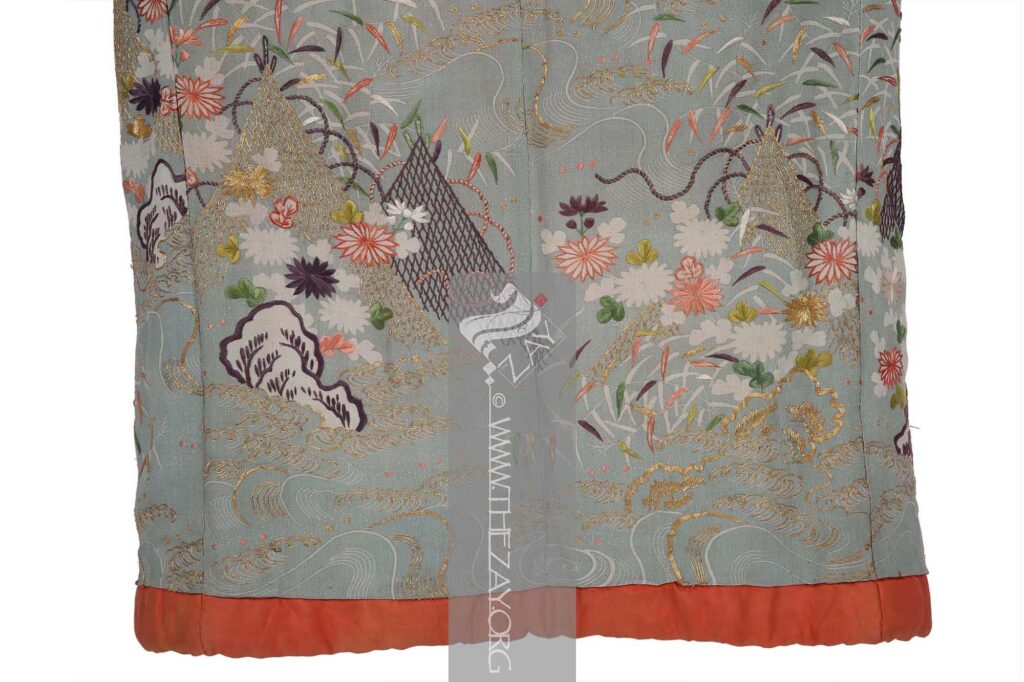 Close up of the kosode
Kosode: (Japanese: small sleeve or opening), a traditional Japanese inner robe for both genders. Similar to a kimono but with a wider body, longer collars, and narrower and rounded sleeves, often stitched to the body, these under robes were lavishly decorated and were worn on top from late 16th century. style kimono
Kimono: (Japanese: ki : wearing, mono: thing, Singular: Kimono) A traditional Japanese long loose robe with wide sleeves tied with a sash around the waist. Presently it is the national dress of Japan. “Jade green silk women’s robe”, Japan c. 1915; Acc No: I2017.500768 ASIA; Source: The Zay
Zay: (Arabic: costume, Pl. azyaā’), a set of clothes in a style typical of a particular country or historical period. Initiative, LINK
Close up of the kosode
Kosode: (Japanese: small sleeve or opening), a traditional Japanese inner robe for both genders. Similar to a kimono but with a wider body, longer collars, and narrower and rounded sleeves, often stitched to the body, these under robes were lavishly decorated and were worn on top from late 16th century. style kimono
Kimono: (Japanese: ki : wearing, mono: thing, Singular: Kimono) A traditional Japanese long loose robe with wide sleeves tied with a sash around the waist. Presently it is the national dress of Japan. “Jade green silk women’s robe”, Japan c. 1915; Acc No: I2017.500768 ASIA; Source: The Zay
Zay: (Arabic: costume, Pl. azyaā’), a set of clothes in a style typical of a particular country or historical period. Initiative, LINK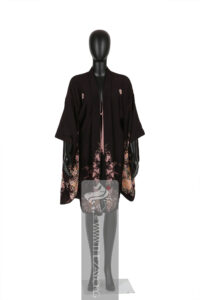 A haori
Haori: It is a type of traditional Japanese jacket traditionally worn over a kimono by men. It features an open front tied with cords. Often made of silk or wool it can be adorned with various designs and patterns, making it a popular garment for formal occasions. jacket; “Plum printed silk women’s jacket”, Japan c. 1920; Acc No: ZI2019.500923 ASIA; Source: The Zay
Zay: (Arabic: costume, Pl. azyaā’), a set of clothes in a style typical of a particular country or historical period. Initiative, LINK
A haori
Haori: It is a type of traditional Japanese jacket traditionally worn over a kimono by men. It features an open front tied with cords. Often made of silk or wool it can be adorned with various designs and patterns, making it a popular garment for formal occasions. jacket; “Plum printed silk women’s jacket”, Japan c. 1920; Acc No: ZI2019.500923 ASIA; Source: The Zay
Zay: (Arabic: costume, Pl. azyaā’), a set of clothes in a style typical of a particular country or historical period. Initiative, LINK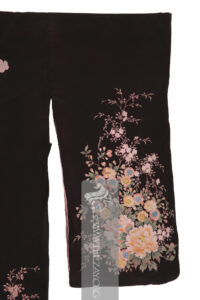 A haori
Haori: It is a type of traditional Japanese jacket traditionally worn over a kimono by men. It features an open front tied with cords. Often made of silk or wool it can be adorned with various designs and patterns, making it a popular garment for formal occasions. jacket; “Plum printed silk women’s jacket”, Japan c. 1920; Acc No: ZI2019.500923 ASIA; Source: The Zay
Zay: (Arabic: costume, Pl. azyaā’), a set of clothes in a style typical of a particular country or historical period. Initiative, LINK
A haori
Haori: It is a type of traditional Japanese jacket traditionally worn over a kimono by men. It features an open front tied with cords. Often made of silk or wool it can be adorned with various designs and patterns, making it a popular garment for formal occasions. jacket; “Plum printed silk women’s jacket”, Japan c. 1920; Acc No: ZI2019.500923 ASIA; Source: The Zay
Zay: (Arabic: costume, Pl. azyaā’), a set of clothes in a style typical of a particular country or historical period. Initiative, LINK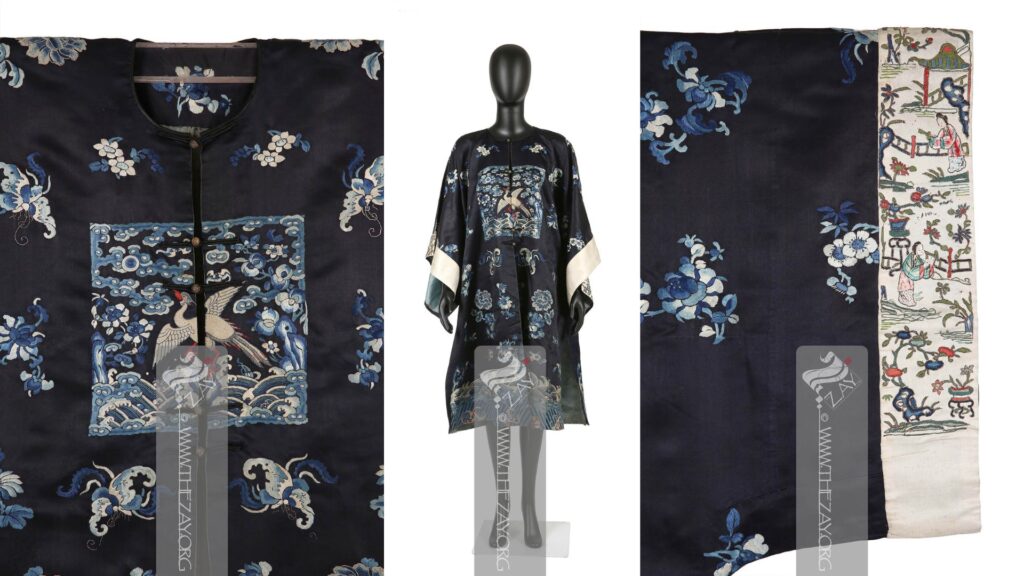 Chinese Surcoat
Surcoat: (Old French: sur – over), is a loose robe or outer coat that could sometimes be worn over an armour and is worn as a part of an insignia of an order of imperial guards or a knighthood. ; “Satin
Sātin: (Arabic: Zaytuni: from Chinese port of Zayton in Quanzhou province where it was exported from and acquired by Arab merchants), one of the three basic types of woven fabric with a glossy top surface and a dull back. Originated in China and was fundamentally woven in silk. embroidered surcoat
Surcoat: (Old French: sur – over), is a loose robe or outer coat that could sometimes be worn over an armour and is worn as a part of an insignia of an order of imperial guards or a knighthood. ”, China c. 19th century; Acc No: ZI2015.500743 ASIA; Source: The Zay
Zay: (Arabic: costume, Pl. azyaā’), a set of clothes in a style typical of a particular country or historical period. Initiative, LINKIt is a mystery as to why Japanese kimonos are so unflatteringly shaped. Historians hold the belief that it can be attributed to two main factors: the strong societal value placed on avoiding waste and the interruption of trade with China. While earlier Chinese fabrics were often cut and stitched, after the discontinuation, it became imperative to use cloth economically as local weavers struggled to meet growing demands. Now that we know the basic history, let us delve into the garments – their style, construction, colour, pattern, distinctions, and names. First, we will look at the two direct predecessors of the kimono
Kimono: (Japanese: ki : wearing, mono: thing, Singular: Kimono) A traditional Japanese long loose robe with wide sleeves tied with a sash around the waist. Presently it is the national dress of Japan. which are still in use.
Chinese Surcoat
Surcoat: (Old French: sur – over), is a loose robe or outer coat that could sometimes be worn over an armour and is worn as a part of an insignia of an order of imperial guards or a knighthood. ; “Satin
Sātin: (Arabic: Zaytuni: from Chinese port of Zayton in Quanzhou province where it was exported from and acquired by Arab merchants), one of the three basic types of woven fabric with a glossy top surface and a dull back. Originated in China and was fundamentally woven in silk. embroidered surcoat
Surcoat: (Old French: sur – over), is a loose robe or outer coat that could sometimes be worn over an armour and is worn as a part of an insignia of an order of imperial guards or a knighthood. ”, China c. 19th century; Acc No: ZI2015.500743 ASIA; Source: The Zay
Zay: (Arabic: costume, Pl. azyaā’), a set of clothes in a style typical of a particular country or historical period. Initiative, LINKIt is a mystery as to why Japanese kimonos are so unflatteringly shaped. Historians hold the belief that it can be attributed to two main factors: the strong societal value placed on avoiding waste and the interruption of trade with China. While earlier Chinese fabrics were often cut and stitched, after the discontinuation, it became imperative to use cloth economically as local weavers struggled to meet growing demands. Now that we know the basic history, let us delve into the garments – their style, construction, colour, pattern, distinctions, and names. First, we will look at the two direct predecessors of the kimono
Kimono: (Japanese: ki : wearing, mono: thing, Singular: Kimono) A traditional Japanese long loose robe with wide sleeves tied with a sash around the waist. Presently it is the national dress of Japan. which are still in use. Junihitoe:
A portmanteau of two Japanese words – juni meaning twelve; and hitoe meaning unlined robes – a (junihitoe) is exactly that – twelve layers of unlined robes. While wearing layered clothing was a direct influence of centuries of cultural exchanges with China, the creation and evolution of the junihitoe was equally native to Japan. Apart from the sudden halt in cultural exchange across the East China Sea, there emerged a ‘native style’ in architecture too. Looking to the past for inspiration, Japanese houses were built a foot or so off the ground, evoking the style of the rice granaries of the past. The rooms had an open plan by which they were separated from the gardens by foldable latticed wall panels. This arrangement fostered a close and intimate relationship with nature. However, these attractive features that continue to be a part of traditional Japanese architectural styles made houses cold and draughty. Although enjoying a steamy summer, the winter months in Japan are usually freezing especially in land-locked areas like Kyoto. Unfortunately, wool remained extremely exotic in Japan until about the 18th century. Thus, Japanese society adopted the layered look to keep themselves warm and comfortable. Interestingly, society’s tendency of exaggeration even with their clothes often led to women sometimes adopting fifteen to forty layers especially at the imperial court, resulting in bouts of swooning and fainting of women due to the overwhelming weight. Interestingly, the original term for layered clothing was karaginumo, which more often than not exceeded twelve layers for women. The term junihitoe to describe layered robes came about by mistake. While deciphering and working on a famous Japanese epic that dealt with a court lady trying to escape her enemies by jumping into a river, historians came across the protagonist being described as wearing twelve layers of unlined robes – junihitoe. Thus, the term was coined to describe any layered and unlined robes worn together. Today the junihitoe is still worn ceremonially, but the number of layers has been exponentially reduced to a far more manageable limit. 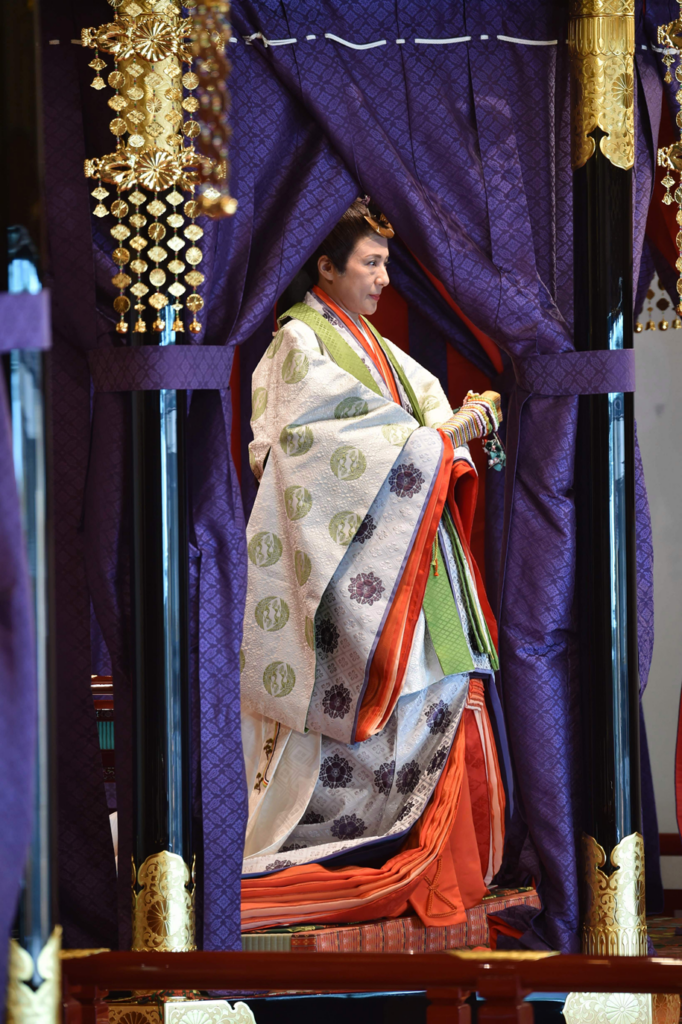 Empress Masako wearing a Junihitoe kimono
Kimono: (Japanese: ki : wearing, mono: thing, Singular: Kimono) A traditional Japanese long loose robe with wide sleeves tied with a sash around the waist. Presently it is the national dress of Japan. in 2019; Wikimedia
Empress Masako wearing a Junihitoe kimono
Kimono: (Japanese: ki : wearing, mono: thing, Singular: Kimono) A traditional Japanese long loose robe with wide sleeves tied with a sash around the waist. Presently it is the national dress of Japan. in 2019; WikimediaKosode
Kosode: (Japanese: small sleeve or opening), a traditional Japanese inner robe for both genders. Similar to a kimono but with a wider body, longer collars, and narrower and rounded sleeves, often stitched to the body, these under robes were lavishly decorated and were worn on top from late 16th century. and Hakama:
Although it cannot be categorized as a kimono
Kimono: (Japanese: ki : wearing, mono: thing, Singular: Kimono) A traditional Japanese long loose robe with wide sleeves tied with a sash around the waist. Presently it is the national dress of Japan. , the (kosode
Kosode: (Japanese: small sleeve or opening), a traditional Japanese inner robe for both genders. Similar to a kimono but with a wider body, longer collars, and narrower and rounded sleeves, often stitched to the body, these under robes were lavishly decorated and were worn on top from late 16th century. ) is the immediate predecessor of the kimono
Kimono: (Japanese: ki : wearing, mono: thing, Singular: Kimono) A traditional Japanese long loose robe with wide sleeves tied with a sash around the waist. Presently it is the national dress of Japan. . It was a wider, looser variant of the kimono
Kimono: (Japanese: ki : wearing, mono: thing, Singular: Kimono) A traditional Japanese long loose robe with wide sleeves tied with a sash around the waist. Presently it is the national dress of Japan. and featured longer collars as well as completely sewn and elaborately round yet narrower sleeves. During the Heian period, the kosode
Kosode: (Japanese: small sleeve or opening), a traditional Japanese inner robe for both genders. Similar to a kimono but with a wider body, longer collars, and narrower and rounded sleeves, often stitched to the body, these under robes were lavishly decorated and were worn on top from late 16th century. was an everyday garment usually made of white or, very rarely, plain red silk. It was worn by both genders. The earliest examples were probably knee-length, so that they could be tucked into loose, wide-legged trousers (hakama). Originally the kosode
Kosode: (Japanese: small sleeve or opening), a traditional Japanese inner robe for both genders. Similar to a kimono but with a wider body, longer collars, and narrower and rounded sleeves, often stitched to the body, these under robes were lavishly decorated and were worn on top from late 16th century. functioned as an undergarment. Constructed out of two full-width cloths sewn together down the back lengthwise and left open in the front. Extra widths of cloths were stitched to the main garment to make the sleeves and construct a front overlap. Usually, the men’s kosode
Kosode: (Japanese: small sleeve or opening), a traditional Japanese inner robe for both genders. Similar to a kimono but with a wider body, longer collars, and narrower and rounded sleeves, often stitched to the body, these under robes were lavishly decorated and were worn on top from late 16th century. , styled after the king’s had a round neck, while women’s kosode
Kosode: (Japanese: small sleeve or opening), a traditional Japanese inner robe for both genders. Similar to a kimono but with a wider body, longer collars, and narrower and rounded sleeves, often stitched to the body, these under robes were lavishly decorated and were worn on top from late 16th century. had a longer V shaped neckline where the outer edge of the collar could be folded to create the first of the colourful multilayer junihitoe. Women also wore kosode
Kosode: (Japanese: small sleeve or opening), a traditional Japanese inner robe for both genders. Similar to a kimono but with a wider body, longer collars, and narrower and rounded sleeves, often stitched to the body, these under robes were lavishly decorated and were worn on top from late 16th century. with a hakama and a wrap in the privacy of their home. On the other hand, over time, the hakama too became long and cumbersome to the point where the end of the hakama legs would often trail behind the wearer like a couple of parallel trains. In fact, the last few years of the Heian period had experienced quite a few fatal fires across the kingdom. The biggest of them all, ended up killing many aristocrats, men and women alike, because their escape was impeded by their cumbersome trailing robes. Some even perished under the weight. These incidents finally led to a substantial reduction of the layering to just five, a number that is still prominent at present, and limited the layered ensemble only to ceremonial occasions. This gave more prominence to the kosode
Kosode: (Japanese: small sleeve or opening), a traditional Japanese inner robe for both genders. Similar to a kimono but with a wider body, longer collars, and narrower and rounded sleeves, often stitched to the body, these under robes were lavishly decorated and were worn on top from late 16th century. , finally making it the primary outerwear with a gradual increase in its length until it reached the wearer’s ankles. 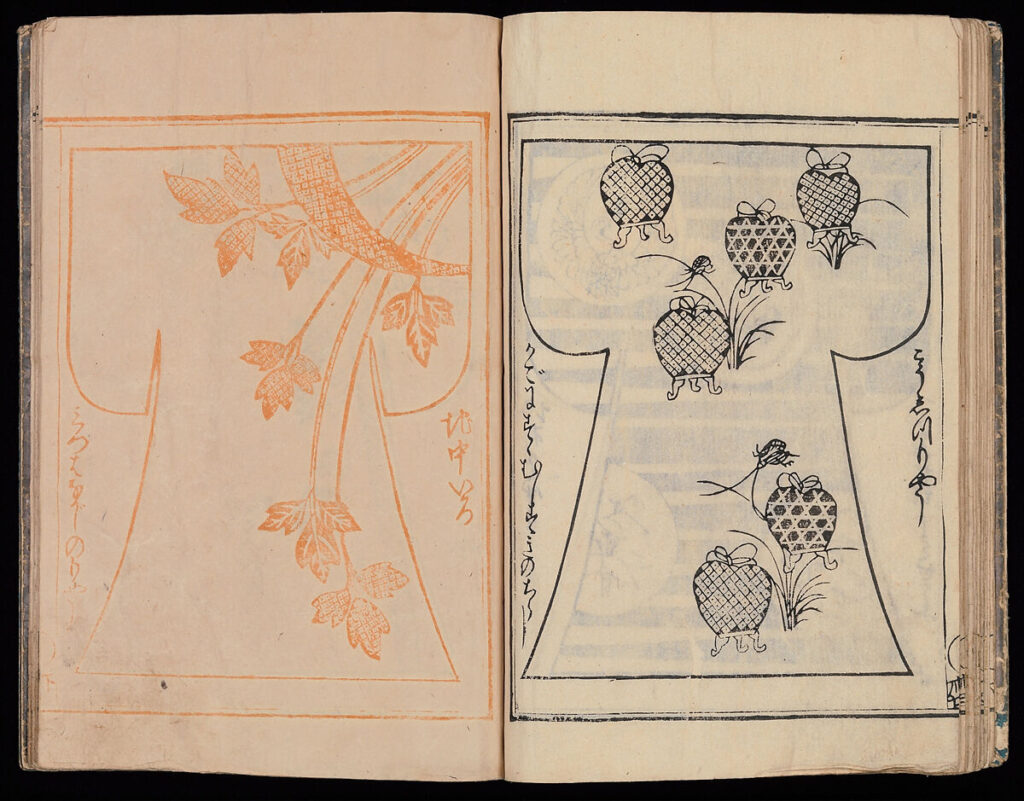 Kosode
Kosode: (Japanese: small sleeve or opening), a traditional Japanese inner robe for both genders. Similar to a kimono but with a wider body, longer collars, and narrower and rounded sleeves, often stitched to the body, these under robes were lavishly decorated and were worn on top from late 16th century. Pattern Book (On-Hiinagata), vol. 2; One of a set of two woodblock-printed books; ink and color on paper; c. 1667, Japan; Credit: Gift of Betty and Paul Nomura, in memory of Nomura Shōjirō, 2018, Metropolitan Museum of Art; Acc. No: 2018.954.5b; LINK
Kosode
Kosode: (Japanese: small sleeve or opening), a traditional Japanese inner robe for both genders. Similar to a kimono but with a wider body, longer collars, and narrower and rounded sleeves, often stitched to the body, these under robes were lavishly decorated and were worn on top from late 16th century. Pattern Book (On-Hiinagata), vol. 2; One of a set of two woodblock-printed books; ink and color on paper; c. 1667, Japan; Credit: Gift of Betty and Paul Nomura, in memory of Nomura Shōjirō, 2018, Metropolitan Museum of Art; Acc. No: 2018.954.5b; LINK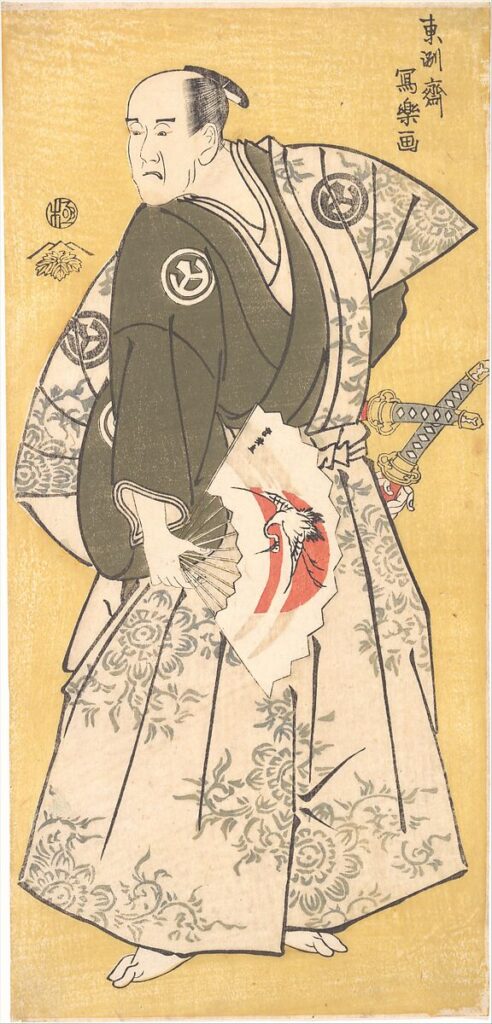 Yamashina Shirojuro in the Role of Nagoya Sanzaemon; Woodblock print; ink and color on paper; Artist: Tōshūsai Sharaku; c. 1794-95, Japan; Credit: Fletcher Fund, 1929, Metropolitan Museum of Art; Acc. No: JP1520;LINK
Yamashina Shirojuro in the Role of Nagoya Sanzaemon; Woodblock print; ink and color on paper; Artist: Tōshūsai Sharaku; c. 1794-95, Japan; Credit: Fletcher Fund, 1929, Metropolitan Museum of Art; Acc. No: JP1520;LINK Share
Tags
Related Post
Leave a comment




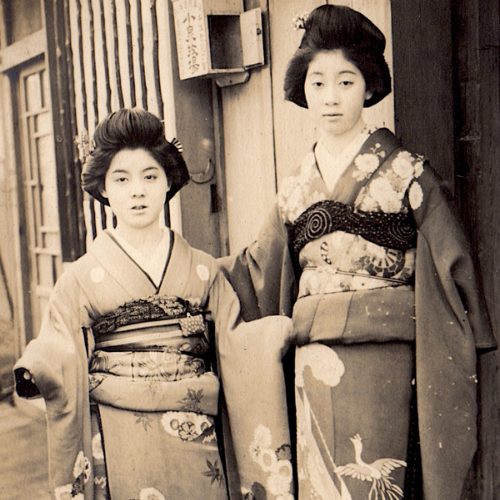
 A later Japanese kosode
Kosode: (Japanese: small sleeve or opening), a traditional Japanese inner robe for both genders. Similar to a kimono but with a wider body, longer collars, and narrower and rounded sleeves, often stitched to the body, these under robes were lavishly decorated and were worn on top from late 16th century. style kimono
Kimono: (Japanese: ki : wearing, mono: thing, Singular: Kimono) A traditional Japanese long loose robe with wide sleeves tied with a sash around the waist. Presently it is the national dress of Japan. ; “Jade green silk women’s robe”, Japan c. 1915; Acc No: ZI2017.500768 ASIA; Source: The Zay
Zay: (Arabic: costume, Pl. azyaā’), a set of clothes in a style typical of a particular country or historical period. Initiative, LINK
A later Japanese kosode
Kosode: (Japanese: small sleeve or opening), a traditional Japanese inner robe for both genders. Similar to a kimono but with a wider body, longer collars, and narrower and rounded sleeves, often stitched to the body, these under robes were lavishly decorated and were worn on top from late 16th century. style kimono
Kimono: (Japanese: ki : wearing, mono: thing, Singular: Kimono) A traditional Japanese long loose robe with wide sleeves tied with a sash around the waist. Presently it is the national dress of Japan. ; “Jade green silk women’s robe”, Japan c. 1915; Acc No: ZI2017.500768 ASIA; Source: The Zay
Zay: (Arabic: costume, Pl. azyaā’), a set of clothes in a style typical of a particular country or historical period. Initiative, LINK Close up of the kosode
Kosode: (Japanese: small sleeve or opening), a traditional Japanese inner robe for both genders. Similar to a kimono but with a wider body, longer collars, and narrower and rounded sleeves, often stitched to the body, these under robes were lavishly decorated and were worn on top from late 16th century. style kimono
Kimono: (Japanese: ki : wearing, mono: thing, Singular: Kimono) A traditional Japanese long loose robe with wide sleeves tied with a sash around the waist. Presently it is the national dress of Japan. “Jade green silk women’s robe”, Japan c. 1915; Acc No: I2017.500768 ASIA; Source: The Zay
Zay: (Arabic: costume, Pl. azyaā’), a set of clothes in a style typical of a particular country or historical period. Initiative, LINK
Close up of the kosode
Kosode: (Japanese: small sleeve or opening), a traditional Japanese inner robe for both genders. Similar to a kimono but with a wider body, longer collars, and narrower and rounded sleeves, often stitched to the body, these under robes were lavishly decorated and were worn on top from late 16th century. style kimono
Kimono: (Japanese: ki : wearing, mono: thing, Singular: Kimono) A traditional Japanese long loose robe with wide sleeves tied with a sash around the waist. Presently it is the national dress of Japan. “Jade green silk women’s robe”, Japan c. 1915; Acc No: I2017.500768 ASIA; Source: The Zay
Zay: (Arabic: costume, Pl. azyaā’), a set of clothes in a style typical of a particular country or historical period. Initiative, LINK A haori
Haori: It is a type of traditional Japanese jacket traditionally worn over a kimono by men. It features an open front tied with cords. Often made of silk or wool it can be adorned with various designs and patterns, making it a popular garment for formal occasions. jacket; “Plum printed silk women’s jacket”, Japan c. 1920; Acc No: ZI2019.500923 ASIA; Source: The Zay
Zay: (Arabic: costume, Pl. azyaā’), a set of clothes in a style typical of a particular country or historical period. Initiative, LINK
A haori
Haori: It is a type of traditional Japanese jacket traditionally worn over a kimono by men. It features an open front tied with cords. Often made of silk or wool it can be adorned with various designs and patterns, making it a popular garment for formal occasions. jacket; “Plum printed silk women’s jacket”, Japan c. 1920; Acc No: ZI2019.500923 ASIA; Source: The Zay
Zay: (Arabic: costume, Pl. azyaā’), a set of clothes in a style typical of a particular country or historical period. Initiative, LINK A haori
Haori: It is a type of traditional Japanese jacket traditionally worn over a kimono by men. It features an open front tied with cords. Often made of silk or wool it can be adorned with various designs and patterns, making it a popular garment for formal occasions. jacket; “Plum printed silk women’s jacket”, Japan c. 1920; Acc No: ZI2019.500923 ASIA; Source: The Zay
Zay: (Arabic: costume, Pl. azyaā’), a set of clothes in a style typical of a particular country or historical period. Initiative, LINK
A haori
Haori: It is a type of traditional Japanese jacket traditionally worn over a kimono by men. It features an open front tied with cords. Often made of silk or wool it can be adorned with various designs and patterns, making it a popular garment for formal occasions. jacket; “Plum printed silk women’s jacket”, Japan c. 1920; Acc No: ZI2019.500923 ASIA; Source: The Zay
Zay: (Arabic: costume, Pl. azyaā’), a set of clothes in a style typical of a particular country or historical period. Initiative, LINK Chinese Surcoat
Surcoat: (Old French: sur – over), is a loose robe or outer coat that could sometimes be worn over an armour and is worn as a part of an insignia of an order of imperial guards or a knighthood. ; “Satin
Sātin: (Arabic: Zaytuni: from Chinese port of Zayton in Quanzhou province where it was exported from and acquired by Arab merchants), one of the three basic types of woven fabric with a glossy top surface and a dull back. Originated in China and was fundamentally woven in silk. embroidered surcoat
Surcoat: (Old French: sur – over), is a loose robe or outer coat that could sometimes be worn over an armour and is worn as a part of an insignia of an order of imperial guards or a knighthood. ”, China c. 19th century; Acc No: ZI2015.500743 ASIA; Source: The Zay
Zay: (Arabic: costume, Pl. azyaā’), a set of clothes in a style typical of a particular country or historical period. Initiative, LINK
Chinese Surcoat
Surcoat: (Old French: sur – over), is a loose robe or outer coat that could sometimes be worn over an armour and is worn as a part of an insignia of an order of imperial guards or a knighthood. ; “Satin
Sātin: (Arabic: Zaytuni: from Chinese port of Zayton in Quanzhou province where it was exported from and acquired by Arab merchants), one of the three basic types of woven fabric with a glossy top surface and a dull back. Originated in China and was fundamentally woven in silk. embroidered surcoat
Surcoat: (Old French: sur – over), is a loose robe or outer coat that could sometimes be worn over an armour and is worn as a part of an insignia of an order of imperial guards or a knighthood. ”, China c. 19th century; Acc No: ZI2015.500743 ASIA; Source: The Zay
Zay: (Arabic: costume, Pl. azyaā’), a set of clothes in a style typical of a particular country or historical period. Initiative, LINK Empress Masako wearing a Junihitoe kimono
Kimono: (Japanese: ki : wearing, mono: thing, Singular: Kimono) A traditional Japanese long loose robe with wide sleeves tied with a sash around the waist. Presently it is the national dress of Japan. in 2019; Wikimedia
Empress Masako wearing a Junihitoe kimono
Kimono: (Japanese: ki : wearing, mono: thing, Singular: Kimono) A traditional Japanese long loose robe with wide sleeves tied with a sash around the waist. Presently it is the national dress of Japan. in 2019; Wikimedia Kosode
Kosode: (Japanese: small sleeve or opening), a traditional Japanese inner robe for both genders. Similar to a kimono but with a wider body, longer collars, and narrower and rounded sleeves, often stitched to the body, these under robes were lavishly decorated and were worn on top from late 16th century. Pattern Book (On-Hiinagata), vol. 2; One of a set of two woodblock-printed books; ink and color on paper; c. 1667, Japan; Credit: Gift of Betty and Paul Nomura, in memory of Nomura Shōjirō, 2018, Metropolitan Museum of Art; Acc. No: 2018.954.5b; LINK
Kosode
Kosode: (Japanese: small sleeve or opening), a traditional Japanese inner robe for both genders. Similar to a kimono but with a wider body, longer collars, and narrower and rounded sleeves, often stitched to the body, these under robes were lavishly decorated and were worn on top from late 16th century. Pattern Book (On-Hiinagata), vol. 2; One of a set of two woodblock-printed books; ink and color on paper; c. 1667, Japan; Credit: Gift of Betty and Paul Nomura, in memory of Nomura Shōjirō, 2018, Metropolitan Museum of Art; Acc. No: 2018.954.5b; LINK Yamashina Shirojuro in the Role of Nagoya Sanzaemon; Woodblock print; ink and color on paper; Artist: Tōshūsai Sharaku; c. 1794-95, Japan; Credit: Fletcher Fund, 1929, Metropolitan Museum of Art; Acc. No: JP1520;LINK
Yamashina Shirojuro in the Role of Nagoya Sanzaemon; Woodblock print; ink and color on paper; Artist: Tōshūsai Sharaku; c. 1794-95, Japan; Credit: Fletcher Fund, 1929, Metropolitan Museum of Art; Acc. No: JP1520;LINK